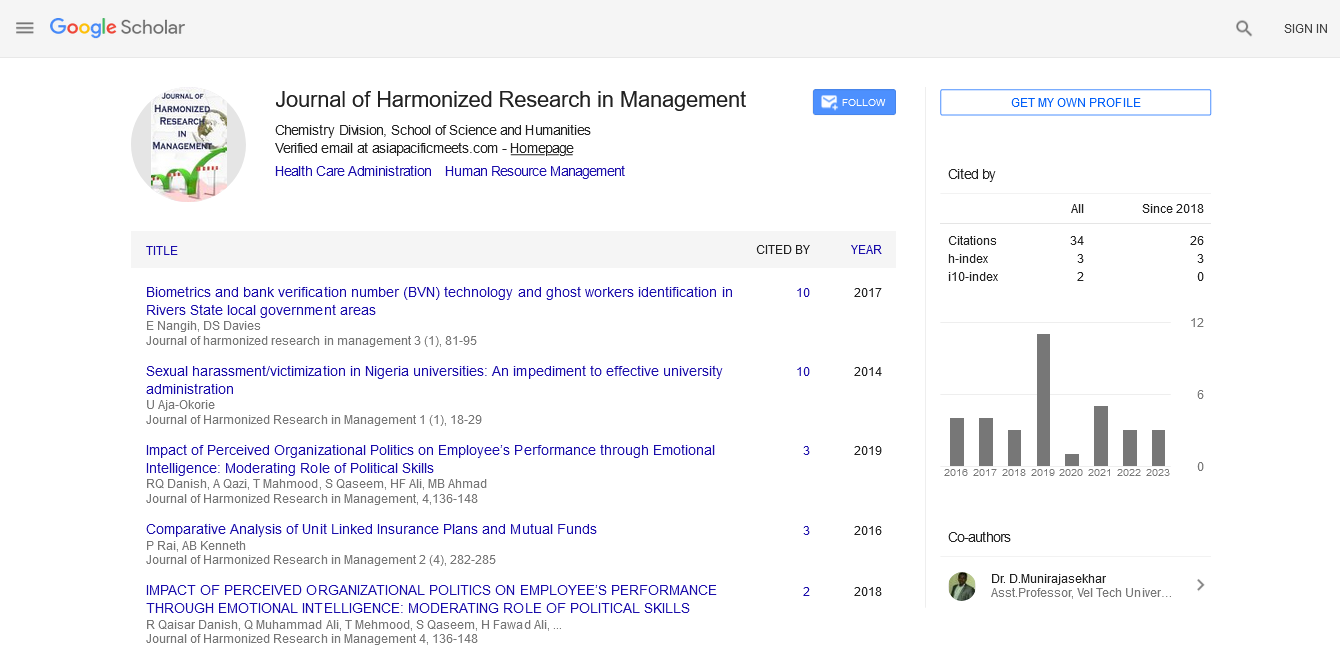Short Communication - (2022) Volume 8, Issue 3
METHODS FOR SELECTING A HUMAN RESOURCES MANAGEMENT PROGRAMME
Timmu Kanungar*Received: Nov 21, 2022, Manuscript No. JHRM-22-77892; Editor assigned: Nov 23, 2022, Pre QC No. JHRM-22-77892 (PQ); Reviewed: Dec 06, 2022, QC No. JHRM-22-77892; Revised: Dec 15, 2022, Manuscript No. JHRM-22-77892 (R); Published: Dec 23, 2022, DOI: 10.30876/2454-5384.22.8.134
Abstract
Description
Human resource management (HRM)
The process of recruiting, hiring, assigning, and managing personnel is known as human resource management (HRM). Frequently, HRM is referred as merely “human resources” (HR). A company’s or organization’s HR department is frequently in charge of creating, implementing, and overseeing the company’s policies surrounding employees and its interactions with them. The phrase “human resources” was initially used to refer to all of the employees of a business in the early 1900s, and it became more popular in the 1960s [1].
Functions of HR
• Hiring process
• Program management
• Rewards and recognition
• Management of employee relations
• Risk evaluation
• Policy planning.
Choose a human resources management programme by the following:-
• A strategic evaluation procedure is frequently necessary for locating the ideal option.
• Identify the organization’s desired outcomes, changes, or improvements, as well as how technology may support achieving them.
• Ensure that the HRMS can keep up with the legislation and regulatory requirements in all relevant jurisdictions, which are changing quickly (local, state, international, etc.).
• Put security first and plan out exactly how sensitive data will be moved, backed up, and stored.
• Seek out deployment methods that include a change management plan to quickly and effectively launch the HRMS.
• Respond to stakeholder queries, worries, and objections to encourage broad HRMS adoption.
• Enquire about service plans to handle the many post-payroll duties required for compliance [2].
Challenges of human resource management
• Penetration of vision
• Industrial relations change
• The business strategy and job design
• An internal setting
• Increasing workforce size
• Systemic psychosocial change
• Accomplishment of a higher level need
• Enhanced organizational capacity [3]
HRM work
Before committing to a company, HR professionals undertake human resource management courses to ensure they are qualified and committed to the human resource department. Despite larger corporations where HR is a full-fledged department with its own hierarchy and HR Director, smaller businesses may only have one or a few HR employees. Similar to how HR generalists would handle everything for start-ups and SMEs, including hiring, payroll administration, performance reviews, and the emergence of company strategies For instance, various persons would be in charge of managing hiring, payroll, benefits, compliance, training, technology, employee safety, wellness, and so forth. The segregation is carried out in order to ensure that enough employees are allocated to meet every need. However, despite the many roles and KRAs, HR personnel’s responsibilities occur simultaneously and are all aimed at maintaining the smooth operation of organizational processes [4].
Human resource management in healthcare
Health care human resource managers are accountable for a wide range of tasks and responsibilities that might affect how a company or organization functions. Human resource managers, on the other hand, can assist doctors in their daily chores and build them up for a long-term professional growth by implementing programming, safety, and training programmes that are considerate of the unusual circumstances encountered by medical professionals. But establishing a supportive work environment where employees are encouraged to look out for themselves and their patient outcomes and work engagement [5].
References
- Andreeva T, Vanhala M, Sergeeva A, Ritala P, Kianto A. When the fit between HR practices backfires: Exploring the interaction effects between rewards for and appraisal of knowledge behaviours on innovation. Hum Resour Manag J. 2017;27(2):209-227.
- Allen DG, Shore LM, Griffeth RW. The role of perceived organizational support and supportive human resource practices in the turnover process. J Manage. 2003;29(1):99-118.
- Demo G, Neiva ER, Nunes I, Rozzett K. Human resources management policies and practices scale (HRMPPS): Exploratory and confirmatory factor analysis. BAR. 2012; 395-420.
- Becker B, Gerhart B. The impact of human resource management on organizational performance: Progress and prospects. Acad Manage J. 1996 ;39(4):779-801.
- Jones DD. Repositioning human resources: a case study.People and strategy. 996; 19(1):51.

Google Scholar citation report
Citations : 92
Journal of Harmonized Research in Management received 92 citations as per google scholar report









